This set of Electric Circuits Multiple Choice Questions & Answers (MCQs) focuses on “Maximum Power Transfer and Superposition”.
1. Which of the following is the example to describe the efficiency of power transfer?
a) Communication systems
b) Power utility systems
c) Instrumentation systems
d) Telecom systems
View Answer
Explanation: Power utility systems are good examples for this case as they are concerned with the generation, transmission and distribution of power in large quantities.
2. In a network maximum power transfer occurs when __________
a) RTh= -RL
b) RTh/RL =0
c) RTh= RL
d) RTh+RL= 1
View Answer
Explanation: Maximum power transfer occurs when load resistance equals the thevenin’s resistance.
3. Maximum power in terms of the thevenin’s voltage and load resistance __________
a) (VTh) 2 /4RL
b) (VTh) 2 *4RL
c) (VTh) 2 +4RL
d) 4RL/ (VTh) 2
View Answer
Explanation: Pmax= v*i= i*R*i= i2RL = (VTh/(RTh+RL))2*RL. Max power occurs when RL=RTh.
4. Calculate the maximum power delivered across RL of the circuit given.
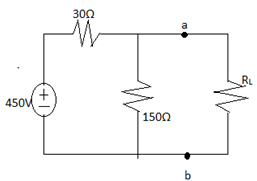
a) 900W
b) 1025W
c) 2025W
d) 1500W
View Answer
Explanation: Pmax= (VTh/(RTh+RL))2*RL (RTh=RL)
VTh= (150/150+30)*540= 450V
RTh=(150*30)/180= 25Ω (the given resistors are in parallel).
5. Determine the maximum power delivered to the load in the network given.
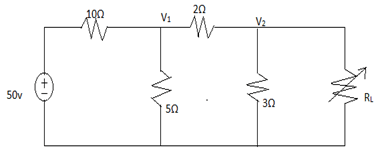
a) 4.68W
b) 5.75W
c) 3.16W
d) 6.84W
View Answer
Explanation: Load is given across node V2 and reference path. It implies the thevenin’s voltage is V2. By using nodal analysis this voltage is found out.
RTh=RL= 10Ω//5Ω and in series with 2Ω and then parallel with 3Ω=1.92Ω
Max power = (VTh) 2 /4RL = 4.688W.
6. The Superposition principle is obeyed by ____________
a) Linear networks
b) Non-linear networks
c) Lateral networks
d) Trilateral networks
View Answer
Explanation: A linear system obeys Superposition Principle. In a linear network parameters are constant i/e/ won’t change with voltage and current.
7. According to Superposition principle response in one element is the algebraic sum of responses by individual sources acting alone.
a) False
b) True
View Answer
Explanation: According to Superposition principle response in one element is the algebraic sum of responses by individual sources acting alone while other sources are non-operative.
8. Find the current in the 3Ω resistor of the given network using Superposition principle.
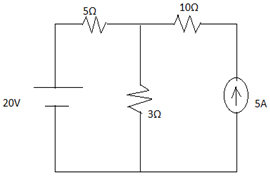
a) 2.5A
b) 3.125A
c) 6.525A
d) 5.625A
View Answer
Explanation: 1.When 20v source acting alone: current source is replaced by open circuit. Req= 5+3=8Ω and Current I= 20/8=2.5A
2. When 5A source acting alone: 20v source is replaced by a short circuit. By current division rule, I3= 25/8=3.125A
Total current through I3= 2.5+3.125=5.625A.
9. Find the current in 5Ω resistor near 12V source using superposition principle in network given
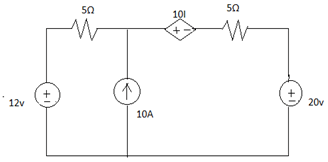
a) 2.9A
b) -2.9A
c) 1A
d) -1A
View Answer
Explanation: Only 3 sources are considered (12V, 10A, 20V), other is dependent (10I).
12v source: I=0.6A
10A source: I=-2.5A through 5Ω resistor and I=7.5A
20v source: I=-1A
Total current = 0.6+ (-2.5) + (-1) = -2.9A.
10. If there are 5 sources in a network out of which 3 are dependent and 2 are independent. For superposition principle ___________ sources are considered.
a) 5
b) 3
c) 2
d) 0
View Answer
Explanation: Only independent sources are considered while using Superposition principle. Dependent sources are never deactivated while using this principle.
11. Find the current in the 1Ω resistor of the given circuit.
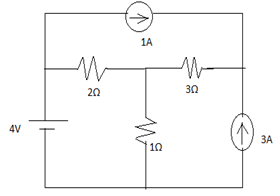
a) 4A
b) 1.33A
c) 2A
d) 0.66A
View Answer
Explanation: when all the sources are acting alone the corresponding currents are found out using current division rule and finally all are summated to get the required current through the1Ω resistor. (Current = 1.33+0.66+2=4A).
12. Find the value of RL in given circuit.
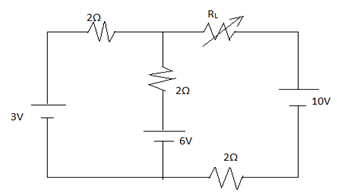
a) 4Ω
b) 5Ω
c) 3Ω
d) 1.66Ω
View Answer
Explanation: RTh=RL= (2//2) + 2=3Ω.
13. Calculate the maximum power delivered to load in the network given.
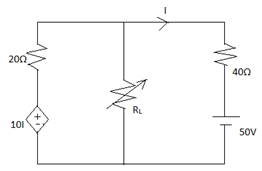
a) 1.56W
b) 1.66W
c) 2.33W
d) 2.79W
View Answer
Explanation: 1.Calculation of VTh. (by using mesh analysis)
2. Calculation of Norton’s current.
3. Calculation of RTh. (RTh=VTh/IN)
4. RTh=RL and PMax= VTh/4RL.
14. In AC networks, maximum power is delivered when __________
a) ZL*ZS*=0
b) ZL+ZS*=1
c) ZL=-ZS*
d) ZL=ZS*
View Answer
Explanation: Max power is delivered when load impedance equals complex conjugate of the source impedance.
15. Superposition principle states that at a time __________ source(S) acts.
a) All the given sources
b) Only voltage sources
c) Only one source
d) Only current sources
View Answer
Explanation: Only one source acts at a time. Remaining sources are non-operative during this period.
Sanfoundry Global Education & Learning Series – Electric Circuits.
To practice all areas of Electric Circuits, here is complete set of 1000+ Multiple Choice Questions and Answers.
If you find a mistake in question / option / answer, kindly take a screenshot and email to [email protected]
- Check Electrical Engineering Books
- Apply for Electrical Engineering Internship
- Practice Electrical Engineering MCQs
- Check Electric Circuits Books
- Practice Electronics & Communication Engineering MCQs
